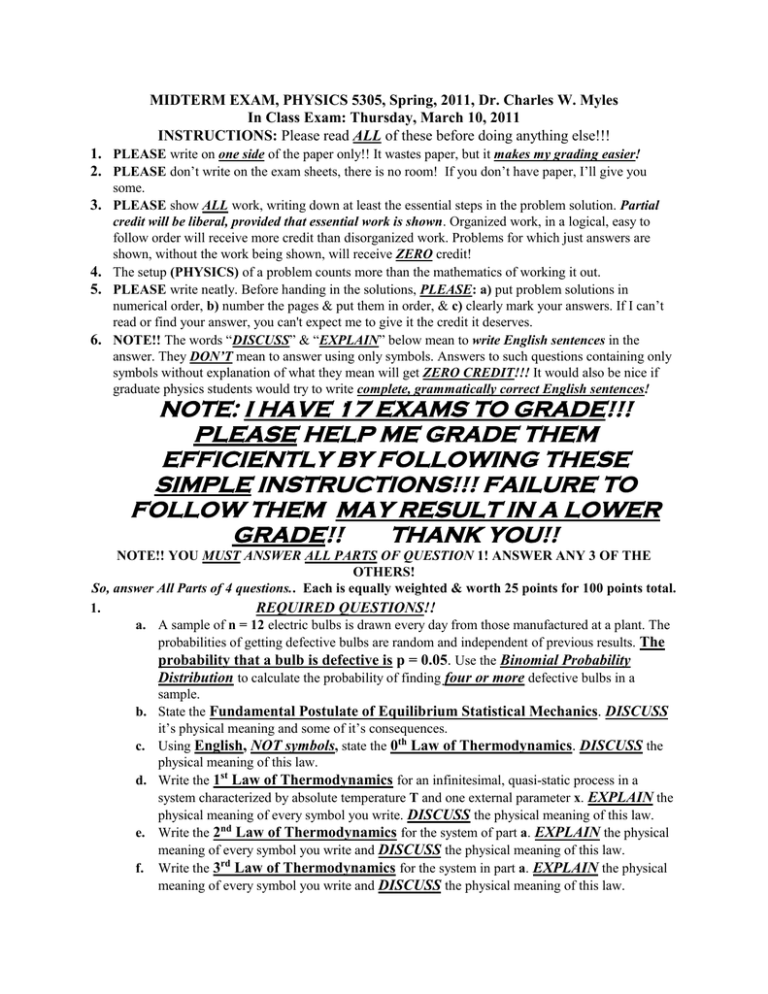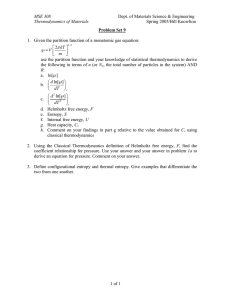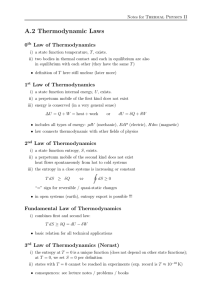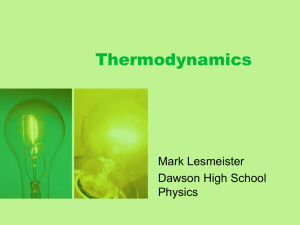MIDTERM EXAM, PHYSICS 5305, Spring, 2011, Dr. Charles W. Myles
advertisement

MIDTERM EXAM, PHYSICS 5305, Spring, 2011, Dr. Charles W. Myles In Class Exam: Thursday, March 10, 2011 INSTRUCTIONS: Please read ALL of these before doing anything else!!! 1. PLEASE write on one side of the paper only!! It wastes paper, but it makes my grading easier! 2. PLEASE don’t write on the exam sheets, there is no room! If you don’t have paper, I’ll give you some. 3. PLEASE show ALL work, writing down at least the essential steps in the problem solution. Partial credit will be liberal, provided that essential work is shown. Organized work, in a logical, easy to follow order will receive more credit than disorganized work. Problems for which just answers are shown, without the work being shown, will receive ZERO credit! 4. The setup (PHYSICS) of a problem counts more than the mathematics of working it out. 5. PLEASE write neatly. Before handing in the solutions, PLEASE: a) put problem solutions in numerical order, b) number the pages & put them in order, & c) clearly mark your answers. If I can’t read or find your answer, you can't expect me to give it the credit it deserves. 6. NOTE!! The words “DISCUSS” & “EXPLAIN” below mean to write English sentences in the answer. They DON’T mean to answer using only symbols. Answers to such questions containing only symbols without explanation of what they mean will get ZERO CREDIT!!! It would also be nice if graduate physics students would try to write complete, grammatically correct English sentences! NOTE: I HAVE 17 EXAMS TO GRADE!!! PLEASE HELP ME GRADE THEM EFFICIENTLY BY FOLLOWING THESE SIMPLE INSTRUCTIONS!!! FAILURE TO FOLLOW THEM MAY RESULT IN A LOWER GRADE!! THANK YOU!! NOTE!! YOU MUST ANSWER ALL PARTS OF QUESTION 1! ANSWER ANY 3 OF THE OTHERS! So, answer All Parts of 4 questions.. Each is equally weighted & worth 25 points for 100 points total. 1. REQUIRED QUESTIONS!! a. A sample of n = 12 electric bulbs is drawn every day from those manufactured at a plant. The probabilities of getting defective bulbs are random and independent of previous results. The probability that a bulb is defective is p = 0.05. Use the Binomial Probability Distribution to calculate the probability of finding four or more defective bulbs in a sample. b. State the Fundamental Postulate of Equilibrium Statistical Mechanics. DISCUSS it’s physical meaning and some of it’s consequences. c. Using English, NOT symbols, state the 0th Law of Thermodynamics. DISCUSS the physical meaning of this law. d. Write the 1st Law of Thermodynamics for an infinitesimal, quasi-static process in a system characterized by absolute temperature T and one external parameter x. EXPLAIN the physical meaning of every symbol you write. DISCUSS the physical meaning of this law. e. Write the 2nd Law of Thermodynamics for the system of part a. EXPLAIN the physical meaning of every symbol you write and DISCUSS the physical meaning of this law. f. Write the 3rd Law of Thermodynamics for the system in part a. EXPLAIN the physical meaning of every symbol you write and DISCUSS the physical meaning of this law. g. Conceptual Question!! (Answer briefly using mostly WORDS. Keep equations to a minimum!) If water were to flow uphill, what would have to happen to it’s temperature if the First Law of Thermodynamics were not to be violated? NOTE!!!! WORK ANY 3 OUT OF PROBLEMS 2 through 6! 2. NOTE: Final answers to all parts of the following problem should be NUMERICAL!! Please DO NOT leave answers to these parts in symbolic form! Consider an isolated system A0, composed of interacting sub-systems A1 & A2 with energies E1 & E2. A1 & A2 are in equilibrium with each other. The energy of A0 is, of course E0 = E1 + E2. The number of degrees of freedom for A1 & A2 are f1 = 1024 & f2 = 2 1024. The number of accessible states for A1 & A2 are Ω1 = K(E1)f1 & Ω2 = K(E2)f2, K is a constant. The number of accessible states for A0 is Ω0 = Ω1Ω2. a. Use logarthims to calculate (numerically!) the ratio: R = Ω0(E1 = 3, E2 = 5)Ω0(E1 = 3.01, E2 = 4.99). (The energies are given in Joules.) b. For the systems A1, A2 and A0, calculate (numerically!) the entropies S1, S2, S0 (in terms of Boltzmann’s constant k). c. Calculate the (numerically!) temperature T (in Kelvin units!) for the system A0. NOTE!!!! WORK ANY 3 OUT OF PROBLEMS 2 through 6! 3. The number of accessible states for a system of N particles confined to volume V, with energy in the range E to E + δE is Ω(E,V,N) = AV[(⅝)N]E[(⅔)N]exp[BNVE]. A & B are constants. The system is in equilibrium at an absolute temperature T. a. Calculate the entropy in terms of E,V and N. b. Calculate the internal energy E as a function of T,V, and N. c. Find the equation of state p(V,T,N) for this system, where p is the pressure. You may find that p is a function of internal energy E. If so, use the results of part b for E = E(T,V,N) to eliminate this E dependence of p. d. Calculate the heat capacity CV,N at constant volume V and constant particle number N. e. Calculate the isothermal compressibility κ [κ -V-1(V/(P)T,N] for this system. f. 5 Point Bonus!! Calculate the heat capacity CP,N at constant pressure p & constant particle number N. NOTE!!!! WORK ANY 3 OUT OF PROBLEMS 2 through 6! 4. An ideal gas contains N non-interacting molecules. It is confined to a 2-dimensional box of area A in the x-y plane, instead of to the usual 3-dimensional volume V. So, it has 2N degrees of freedom. It is at thermal equilibrium at absolute temperature T. a. Consider this gas for fixed internal energy E. By an analysis similar to that done in class and in our textbook, DERIVE the dependence of the number of accessible states (E) on the internal energy E and on the area A. (Note: Even if you know the correct result without going through the derivation, write the essential steps of the derivation anyway. Do this in sufficient detail to convince me that you know what to do for this question). b. Calculate dependence of the entropy S of this gas on the internal energy E and on the area A. c. Derive the relation between the absolute temperature T and the internal energy E for this gas. d. Assume that the pressure p for this gas is defined similarly to the way it is defined for the 3-dimensional gas & that p is the generalized force associated with the external parameter A. Derive the equation of state for this gas. (That is, derive the “ideal gas law” for 2 dimensions). NOTE!!!! WORK ANY 3 OUT OF PROBLEMS 2 through 6! 5. A solid contains N magnetic atoms of spin ½. At high enough temperatures (T ∞), each spin is randomly oriented, so that it is equally likely to be in either of its two possible states. This is called the paramagnetic state. The total number of accessible microstates in this paramagnetic macrostate with T ∞, is thus Ω = 2N. At temperatures below a critical temperature T0, the interactions between the magnetic atoms cause them to all be lined up in the same direction. This is called the ferromagnetic state. A measurement of the heat capacity of this system below T0 shows that it has the form: C(T) = D[4(T/T0)3 – 1], for T0 < T < T0 (D is a constant) = 0, otherwise. For this system, use the 2nd Law of Thermodynamics (for an entropy change ΔS in terms of a temperature integral involving the heat capacity C(T)) to CALCULATE: a. An explicit expression for the constant D (in terms of N & Boltzmann’s constant k). b. The entropy S of the system as a function of temperature T, S(T). c. The internal energy E as a function of temperature T, E(T). Assume that there are no relevant external parameters. d. When the system is in it’s ferromagnetic state (with temperature T below T0), the temperature is increased from a value T1 to a higher value T2. Calculate the heat Q that is needed to raise the temperature from T1 to T2. e. Conceptual Question!! Please answer briefly, using complete, grammatically correct English sentences. If you completed parts a & b correctly, you should have used the 2nd Law of Thermodynamics to calculate the entropy change S. However, did you also use the 3rd Law of Thermodynamics? If so, briefly EXPLAIN how you used it. NOTE!!!! WORK ANY 3 OUT OF PROBLEMS 2 through 6! 6. NOTE: Final answers to parts a, b, & c of the following problem should be NUMERICAL!! Please DO NOT leave answers to these parts in symbolic form! Consider the chemical reaction A + B C. The molar heat capacities (in J/(mole-K)) at constant pressure of substances A, B, and C are the following functions of absolute temperature T: CA = 5T(4/3), CB = 3T(3/2), CC = 25T. This reaction is carried out at constant temperature T = 300K. For this reaction, use the 2nd Law of Thermodynamics (for an entropy change ΔS in terms of a temperature integral involving the heat capacity C(T)) to (numerically!) CALCULATE: a. The entropy change per mole, S, of substance C produced. b. The heat released per mole, Q, of substance C produced. c. The change in internal energy per mole E produced in this reaction. Assume that the mechanical work, W, done in this reaction is zero. Parts d & e are Conceptual Questions! !! Please answer them briefly, using complete, grammatically correct English sentences. d. Does the sign of your answer to part a violate the 2nd Law of Thermodynamics? If not, why not? EXPLAIN your answer. e. If you completed part a correctly, you should have used the 2nd Law of Thermodynamics to calculate the entropy change S. However, did you also use the 3rd Law of Thermodynamics? If so, briefly EXPLAIN how you used it.





